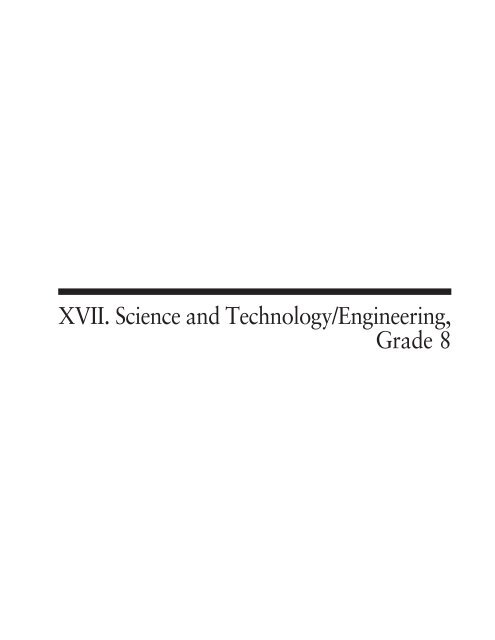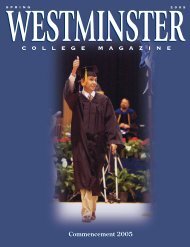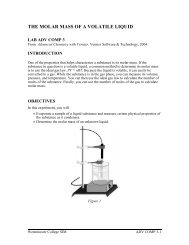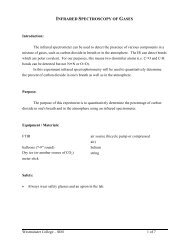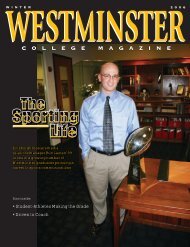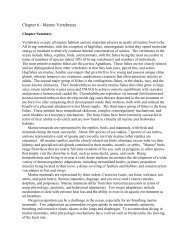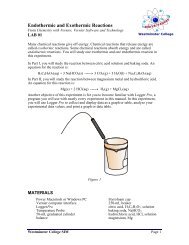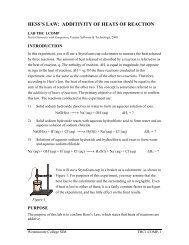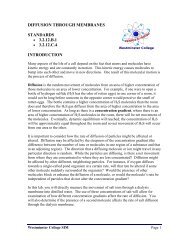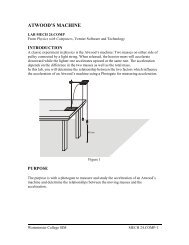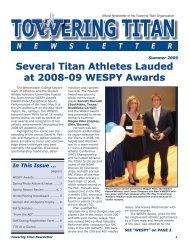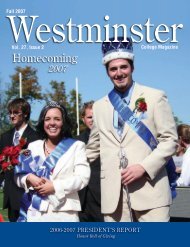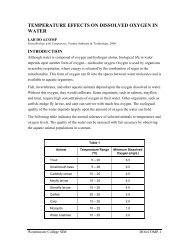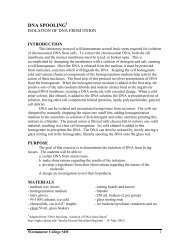Grade 8 Science and Technology/Engineering Test
Grade 8 Science and Technology/Engineering Test
Grade 8 Science and Technology/Engineering Test
- No tags were found...
You also want an ePaper? Increase the reach of your titles
YUMPU automatically turns print PDFs into web optimized ePapers that Google loves.
XVII. <strong>Science</strong> <strong>and</strong> <strong>Technology</strong>/<strong>Engineering</strong>,<strong>Grade</strong> 8
<strong>Grade</strong> 8 <strong>Science</strong> <strong>and</strong><strong>Technology</strong>/<strong>Engineering</strong> <strong>Test</strong>The spring 2006 <strong>Grade</strong> 8 MCAS <strong>Science</strong> <strong>and</strong> <strong>Technology</strong>/<strong>Engineering</strong> <strong>Test</strong> was based on learningst<strong>and</strong>ards in the Massachusetts <strong>Science</strong> <strong>and</strong> <strong>Technology</strong>/<strong>Engineering</strong> Curriculum Framework (2001).The Framework identifies four major content str<strong>and</strong>s listed below. Page numbers for the grades 6–8learning st<strong>and</strong>ards appear in parentheses.■ Earth <strong>and</strong> Space <strong>Science</strong> (Framework, pages 29–30)■ Life <strong>Science</strong> (Biology) (Framework, pages 46–48)■ Physical <strong>Science</strong>s (Chemistry <strong>and</strong> Physics) (Framework, pages 60–62)■ <strong>Technology</strong>/<strong>Engineering</strong> (Framework, pages 76–79)The <strong>Science</strong> <strong>and</strong> <strong>Technology</strong>/<strong>Engineering</strong> Curriculum Framework is available on the DepartmentWeb site at www.doe.mass.edu/frameworks/scitech/2001/0501.pdf.In <strong>Test</strong> Item Analysis Reports <strong>and</strong> on the Subject Area Subscore pages of the MCAS School Reports<strong>and</strong> District Reports, <strong>Science</strong> <strong>and</strong> <strong>Technology</strong>/<strong>Engineering</strong> test results are reported under fourMCAS reporting categories, which are identical to the four Curriculum Framework content str<strong>and</strong>slisted above.<strong>Test</strong> SessionsThe MCAS <strong>Grade</strong> 8 <strong>Science</strong> <strong>and</strong> <strong>Technology</strong>/<strong>Engineering</strong> <strong>Test</strong> included two separate testsessions. Each session included multiple-choice <strong>and</strong> open-response questions.Reference Materials <strong>and</strong> ToolsThe use of bilingual word-to-word dictionaries was allowed for limited English proficient studentsonly, during both <strong>Science</strong> <strong>and</strong> <strong>Technology</strong>/<strong>Engineering</strong> test sessions. No other reference tools ormaterials were allowed.Cross-Reference InformationThe table at the conclusion of this chapter indicates each item’s reporting category <strong>and</strong> theFramework learning st<strong>and</strong>ard it assesses. The correct answers for multiple-choice questions are alsodisplayed in the table.398
<strong>Science</strong> <strong>and</strong> <strong>Technology</strong>/<strong>Engineering</strong>SESSION 1DIRECTIONSThis session contains seventeen multiple-choice questions <strong>and</strong> two open-response questions. Markyour answers to these questions in the spaces provided in your Student Answer Booklet.ID:227898 D Common●1The terms gas exchange, diaphragm, <strong>and</strong>inhale are most closely associated withwhich system in the human body?A. circulatoryB. digestiveC. excretoryD. respiratoryID:229373 3227109_AR1.eps B Common●3The drawing below shows part of agraduated cylinder containing liquid.8070ID:227913 A Common●2What are the basic structural units ofliving organisms?A. cellsB. nucleiC. organsD. tissuesBased on the sensitivity of the graduatedcylinder, what is the volume of the liquid?A. 70.5 mLB. 73.0 mLC. 76.7 mLD. 87.0 mLID:229473 C Common●4Where is an igneous rock such aspumice most likely formed?A. in a desertB. in a creek bedC. near a volcanoD. under a glacier399
<strong>Science</strong> <strong>and</strong> <strong>Technology</strong>/<strong>Engineering</strong> Session 1ID:229461 3189002_AR1.eps B CommonID:229444 3227121_AR1.eps A Common● 5 The illustration below shows a cloth ● 6 The graph below relates distance to timebanner made to advertise a county fair.for a rolling ball.50'C O U N T Y F A I RSeptember 4–610'1412This sign will be hung across the mainstreet of a town between two metal utilitypoles. Which of the following materialswould be the best to use to attach the signto the poles?Distance (m)10864A. nailsB. ropesC. staplesD. tape20 1 2 3 4 5 6 7Time (s)What is the average speed of the ball?A. 2 m/sB. 6 m/sC. 8 m/sD. 72 m/s400
<strong>Science</strong> <strong>and</strong> <strong>Technology</strong>/<strong>Engineering</strong> Session 1ID:229372 3189018_AR1.eps B Common● 7The diagram below shows what occurredwhen a can of diet soda <strong>and</strong> a can ofregular soda were dropped into a containerof water.ID:229376 3227054_AR1.eps A Common● 8The diagram below shows thechromosomes from a cell after theywere photographed under a microscope.DietRegularThe can of regular soda sank to the bottomof the container, but the can of diet sodafloated. Which of the following statementsbest explains this observation?A. The can of regular soda is less densethan the can of diet soda.B. The can of regular soda is more densethan the can of diet soda.C. The can of regular soda has a largervolume than the can of diet soda.D. The can of regular soda has a smallervolume than the can of diet soda.Which of the following questionsmay best be answered by studyingan organism’s chromosomes?A. What sex is the organism?B. Is the organism endangered?C. Where is the organism’secosystem?D. How does the organism obtainits food?401
<strong>Science</strong> <strong>and</strong> <strong>Technology</strong>/<strong>Engineering</strong>Session 1Questions 18 <strong>and</strong> 19 are open-response questions.ID:252635 Common●18• BE SURE TO ANSWER AND LABEL ALL PARTS OF EACH QUESTION.• Show all your work (diagrams, tables, or computations) in your Student Answer Booklet.• If you do the work in your head, explain in writing how you did the work.Write your answer to question 18 in the space provided in your Student Answer Booklet.A new type of sneaker is being designed for athletes who play on hard surfaces.a. List three divisions of the manufacturing organization involved in the design,manufacture, <strong>and</strong> promotion of this new style of sneaker.b. Describe the general role of each division you identified in part (a).406
<strong>Science</strong> <strong>and</strong> <strong>Technology</strong>/<strong>Engineering</strong> Session 1Write your answer to question 19 in the space provided in your Student Answer Booklet.ID:250795 3238689_AR1.eps Common● 19 The diagram below shows two l<strong>and</strong> masses separated by an ocean.KeyS<strong>and</strong>stoneL<strong>and</strong> mass 1OceanL<strong>and</strong> mass 2LimestonePlant fossillocationA scientist is studying these two l<strong>and</strong> masses. The scientist hypothesizes that the l<strong>and</strong> masseswere once together.a. Using the diagram, identify two pieces of evidence that support the scientist’s theory that thel<strong>and</strong> masses were once together.b. Explain how each piece of evidence you identified supports the scientist’s hypothesis.407
<strong>Science</strong> <strong>and</strong> <strong>Technology</strong>/<strong>Engineering</strong>Session 2ID:250797 3227048_AR1.eps B Common●22About 300 million years ago, the l<strong>and</strong> of Earth was in a single mass known as Pangaea, as shown inFigure A. About 150 million years ago, Pangaea broke up into the l<strong>and</strong> masses shown in Figure B.equatorPangaeaequatorXX300 million years ago 150 million years agoFigure AFigure BBased on the diagrams, which of the following were more likely to survive on continent Xafter the breakup of Pangaea than before it broke apart?A. organisms that lived in fresh waterB. organisms that required warm conditionsC. organisms that hibernated for long periodsD. organisms that traveled great distances during migrations409
<strong>Science</strong> <strong>and</strong> <strong>Technology</strong>/<strong>Engineering</strong>Session 2ID:252638 3316804_AR1.eps, 3316804_ D Common●23Which of the following graphs bestrepresents the relationship betweendensity <strong>and</strong> depth of material belowEarth’s surface?A.B.C.D.Density Density Density DensityLithosphereLithosphereLithosphereDepthDepthDepthCoreCoreCoreID:227900 A Common●24ID:252641 B Common●25A glass is partially filled with water.Five ice cubes are placed in the glass,causing the level of the water to reachthe rim of the glass. Which of thefollowing statements best explains theincrease in water level?A. The volume of the submerged iceis equal to the volume of waterdisplaced.B. The mass of the water inthe glass is less than the massof the ice.C. The weight of the ice is lessthan the weight of the water inthe glass.D. The density of the water inthe glass is greater than thedensity of the ice.Sal is looking at a map ofMassachusetts. He has measured thedistance, in inches, from Boston toSalem on the map. He wants to knowhow many actual miles the inchesrepresent.What feature of the map should helook for?A. keyB. scaleC. legendD. compassLithosphereDepthCore410
<strong>Science</strong> <strong>and</strong> <strong>Technology</strong>/<strong>Engineering</strong>Session 2ID:229403 3152050_AR1.eps A Common●26The diagram below shows a balance being used to measure a burning c<strong>and</strong>le in a sealed glass ballbefore <strong>and</strong> after the burning is complete.BeforeAfterAs the c<strong>and</strong>le burns, the size of the c<strong>and</strong>le decreases, but the reading on the balance does notchange. Which of the following is demonstrated by this experiment?A. The total mass of the system is constant.B. Energy is converted to mass when the c<strong>and</strong>le is burned.C. Smoke particles have more mass than molecules of c<strong>and</strong>le wax.D. Kinetic energy is converted to potential energy when the c<strong>and</strong>le is burned.411
<strong>Science</strong> <strong>and</strong> <strong>Technology</strong>/<strong>Engineering</strong>Session 2ID:226418 3189033_AR1.eps C Common●27Eurasian PlateOn the map below, dark circles indicatethe positions of volcanoes in the “Ringof Fire” in <strong>and</strong> around the Pacific Ocean.Dark lines indicate tectonic plateboundaries of Earth’s crust.NorthAmericanPlateID:229445 3189022_AR1.eps D Common●28The two beakers below contain pure water.100 mL025507510075502550 mL0255025Indo-Australian PlateCocos PlatePacific PlateKeyPlate boundaryVolcanoNazcaPlateWhich of the following properties is thesame for both of these samples?A. massB. weightC. volumeD. boiling pointAccording to this map, which of thefollowing describes where volcanoes aremost likely to form in the Ring of Fire?A. Volcanoes form in the middle of atectonic plate.B. Volcanoes form below the surfaceof tectonic plates.C. Volcanoes form where tectonic platesmeet other plates.D. Volcanoes form where earthquakesare least likely to occur.412
<strong>Science</strong> <strong>and</strong> <strong>Technology</strong>/<strong>Engineering</strong>Session 2ID:252642 A Common●29Index fossils help scientists estimatethe age of a rock because index fossilspecies only existed for a relatively shorttime. What happened to the species thatare now used as index fossils?A. They became extinct.B. They changed their diets.C. They hid in marine sediments.D. They migrated to new environments.ID:229383 3227113_AR1.eps, 3227113_ C Common●30Below are four ball-<strong>and</strong>-stick modelsrepresenting compounds. Which of thesemodels best represents ammonia (NH 3)?A.B.C.D.413
<strong>Science</strong> <strong>and</strong> <strong>Technology</strong>/<strong>Engineering</strong>Session 2ID:229486 D Common●31Students are studying the process ofphotosynthesis in plants. Which of thefollowing is a product of photosynthesis?A. carbon dioxideB. nitrogenC. sodium chlorideD. sugarID:229397 3227107_AR1.eps, 3227107_ C Common●32Which of the following instruments isbest to use to measure the volume of asmall irregularly shaped solid?A.Triple beam balanceB. 0 cm 1 2 3 4 5 6 7 8 9 10 11 12 13 14 15 16 17 180 in 1 2 3 4 5 6 7RulerC.mL25020015010050Graduated cylinderD.Thermometer414
<strong>Science</strong> <strong>and</strong> <strong>Technology</strong>/<strong>Engineering</strong>Session 2ID:229436 3152029_AR1.eps A Common●33The following diagram shows a caterpillar, mold, <strong>and</strong> a fern.CaterpillarMoldFernWhat do these organisms have in common?A. They are made of cells.B. They produce their own food.C. They decompose other organisms.D. They are disease-causing organisms.415
<strong>Science</strong> <strong>and</strong> <strong>Technology</strong>/<strong>Engineering</strong>Session 2ID:229420 D Common●34Spirogyra are green algae that canreproduce sexually. Which of thefollowing features identifies reproductionin Spirogyra as sexual reproduction?ID:252644 3189005_AR1.eps D Common●36The illustration below shows anarchitect’s model of an office building.A. The cells of parent algae have nuclei.B. Each offspring contains chloroplasts.C. Several offspring may be producedat once.D. Genetic material is contributed by twoparent cells.ID:229419 A Common●35The Moon orbits Earth at a speed ofapproximately one kilometer per second.The Moon is kept in orbit by which ofthe following?A. gravityB. lunar phasesC. magnetismD. ocean tidesWhich of the following is most likelythe purpose of this model?A. to guide the drafting of thebuilding’s plansB. to test the strength of theconstruction techniqueC. to inventory the materialsneeded for constructionD. to show some of the characteristicsof the finished structure416
<strong>Science</strong> <strong>and</strong> <strong>Technology</strong>/<strong>Engineering</strong> Session 2Questions 37 through 39 are open-response questions.• BE SURE TO ANSWER AND LABEL ALL PARTS OF EACH QUESTION.• Show all your work (diagrams, tables, or computations) in your Student Answer Booklet.• If you do the work in your head, explain in writing how you did the work.Write your answer to question 37 in the space provided in your Student Answer Booklet.ID:229369 3227031_AR1.eps Common● 37 The diagrams below show an Amoeba <strong>and</strong> a Chlamydomonas.Diagram ADiagram BFoodvacuoleFoodparticlePseudopodFlagellaCell wallMitochondrionNucleusNucleusChloroplastAmoeba0 100 µmChlamydomonas0 5 µmBoth organisms can be seen only with a microscope. Since these are one-celled organisms,each cell must be able to carry out all important life functions, such as moving from place toplace <strong>and</strong> getting food.a. Compare the ways these two organisms move. Be sure to include information from thediagrams in your answer.b. Compare the ways these two organisms obtain nutrients. Be sure to include informationfrom the diagrams in your answer.417
<strong>Science</strong> <strong>and</strong> <strong>Technology</strong>/<strong>Engineering</strong>Session 2Write your answer to question 38 in the space provided in your Student Answer Booklet.ID:229365 Common●38A science class is studying physical <strong>and</strong> chemical changes.The teacher puts a beaker of water onto a hot plate <strong>and</strong> heats it until bubbles appear.a. Classify this as a physical or chemical change. Explain your reasoning using specific details.The teacher puts a sugar cube into a container of warm water. Eventually the sugar cube isno longer visible.b. Classify this as a physical or chemical change. Explain your reasoning using specific details.The teacher pours vinegar into a small container of baking soda. The combined substancesbegin to fizz <strong>and</strong> bubble as a gas is released.c. Classify this as a physical or chemical change. Explain your reasoning using specific details.418
<strong>Science</strong> <strong>and</strong> <strong>Technology</strong>/<strong>Engineering</strong>Session 2Write your answer to question 39 in the space provided in your Student Answer Booklet.ID:229380 3209590_AR1.eps Common●39The diagram below shows several labeled parts of a house.FramingSiding Insulation Foundationa. Describe the function of the house’s foundation.b. The framing, insulation, <strong>and</strong> siding make up the wall system of this house. Explain thefunction of each of these parts.419
<strong>Grade</strong> 8 <strong>Science</strong> <strong>and</strong> <strong>Technology</strong>/<strong>Engineering</strong>Spring 2006 Released Items:Reporting Categories, St<strong>and</strong>ards, <strong>and</strong> Correct AnswersItem No. Page No. Reporting Category St<strong>and</strong>ardCorrect Answer(MC)*1 399 Life <strong>Science</strong> (Biology) 6 D2 399 Life <strong>Science</strong> (Biology) 5 A3 399 Physical <strong>Science</strong>s (Chemistry <strong>and</strong> Physics) 3 B4 399 Earth <strong>and</strong> Space <strong>Science</strong> 6 C5 400 <strong>Technology</strong>/<strong>Engineering</strong> 1.1 B6 400 Physical <strong>Science</strong>s (Chemistry <strong>and</strong> Physics) 12 A7 401 Physical <strong>Science</strong>s (Chemistry <strong>and</strong> Physics) 2 B8 401 Life <strong>Science</strong> (Biology) 8 A9 402 Life <strong>Science</strong> (Biology) 11 B10 402 Physical <strong>Science</strong>s (Chemistry <strong>and</strong> Physics) 14 D11 403 Life <strong>Science</strong> (Biology) 13 A12 403 Earth <strong>and</strong> Space <strong>Science</strong> 1 D13 403 <strong>Technology</strong>/<strong>Engineering</strong> 7.2 C14 404 <strong>Technology</strong>/<strong>Engineering</strong> 2.2 D15 404 Earth <strong>and</strong> Space <strong>Science</strong> 12 A16 405 Earth <strong>and</strong> Space <strong>Science</strong> 7 C17 405 <strong>Technology</strong>/<strong>Engineering</strong> 2.6 A18 406 <strong>Technology</strong>/<strong>Engineering</strong> 4.319 407 Earth <strong>and</strong> Space <strong>Science</strong> 720 408 Life <strong>Science</strong> (Biology) 2 D21 408 <strong>Technology</strong>/<strong>Engineering</strong> 6.3 A22 409 Life <strong>Science</strong> (Biology) 10 B23 410 Earth <strong>and</strong> Space <strong>Science</strong> 2 D24 410 Physical <strong>Science</strong>s (Chemistry <strong>and</strong> Physics) 2 A25 410 Earth <strong>and</strong> Space <strong>Science</strong> 1 B26 411 Physical <strong>Science</strong>s (Chemistry <strong>and</strong> Physics) 4 A27 412 Earth <strong>and</strong> Space <strong>Science</strong> 1 C28 412 Physical <strong>Science</strong>s (Chemistry <strong>and</strong> Physics) 9 D29 413 Earth <strong>and</strong> Space <strong>Science</strong> 7 A30 413 Physical <strong>Science</strong>s (Chemistry <strong>and</strong> Physics) 7 C31 414 Life <strong>Science</strong> (Biology) 16 D32 414 Physical <strong>Science</strong>s (Chemistry <strong>and</strong> Physics) 2 C33 415 Life <strong>Science</strong> (Biology) 2 A34 416 Life <strong>Science</strong> (Biology) 9 D35 416 Earth <strong>and</strong> Space <strong>Science</strong> 8 A36 416 <strong>Technology</strong>/<strong>Engineering</strong> 2.2 D37 417 Life <strong>Science</strong> (Biology) 238 418 Physical <strong>Science</strong>s (Chemistry <strong>and</strong> Physics) 1039 419 <strong>Technology</strong>/<strong>Engineering</strong> 5.1* Answers are provided here for multiple-choice items only. Sample responses <strong>and</strong> scoring guidelines for open-response items,which are indicated by shaded cells, will be posted to the Department’s Web site later this year.420


